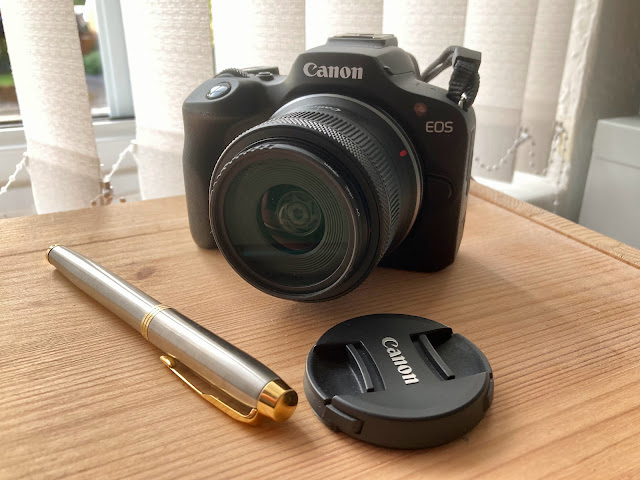Like many photographers out there, the toughest decision I have to make when going on holiday is not what clothes to pack but rather what cameras to take with me. I'm a keen amateur who likes digital and film and so it usually means packing more than one camera. This trip was to Grasmere with plans of visiting; Allan Bank, Rydal Water and Rydal Hall, Grasmere and Grasmere Lake, Ambleside, Waterhead as well as a few other places. In the Lake District you are spoilt for choice, it is such a beautiful place for photography.
I looked through my cameras and decided that I needed to travel light as I would be doing a fair amount of walking but also needed the flexibility of both digital and film cameras. After an ‘agonising’ struggle I settled on the following:
My new Canon EOS R100 with the 18-45mm kit lens. Small and lightweight. At just 356g, this is one of the lightest interchangeable lens cameras around. The EOS R100 is a stripped-back version of Canon’s DSLR-style Canon EOS R50 with the same 24MP APS-C crop sensor that has been around for many years. It was a good option for my limited budget with reported excellent image quality.
My back-up digital camera was my Canon Powershot G7X. Although and older camera (2014) it takes excellent pictures, has a brilliant macro mode, is very small and light but also tough. The fold-out screen makes taking low angle shots easier for me, being an older photographer. The G7X was the company's first compact camera with a 1"- type sensor. This 20.2MP BSI-CMOS sensor is paired with Canon's DIGIC 6 image processor, and offers an ISO range of 125-12800. The lens has a fast maximum aperture range of F1.8-2.8 and equivalent focal range of 24-100mm. It has a 9-blade curved aperture diagram as well as an ND filter.
One of the film cameras on this trip had to be my Olympus MJU-1 point-and-shoot. It's a small, lightweight easy to use camera by the legendary designer Maitani Yoshihisa. The Olympus Mju-1 handles 50-3200 iso film; has shutter times of 1/15 to 1/500 sec.; a minimum focusing distance of only 35 cm; a 3 element, 3 group lens, and maximum f3,5. It has autofocus, a motor drive, and an automatic flash, and it’s powered by a CR123 (A) battery. This is the lightest camera in my collection and slips easily into a coat pocket.
Finally, I decided to take along my wife’s old Zenit B. I had recently refurbished this camera that had not seen use since the mid 70s. A good clean up and the use of isopropyl alcohol electronics cleaning solution applied carefully with cotton buds on some of the now stiff moving parts eventually appeared to have the Zenit in working order. This model, from 1969 was equipped with the Industar-50-2 50mm f/3.5 lens. There is no built-in light-meter (like the Zenit E), so I packed my Leningrad meter. Unlike the other two cameras the Zenit B is not a lightweight camera and has a solid metal casing and lens. In fact it's like carrying a house brick around with you all day. But I really wanted to check it out to see if my careful TLC had paid off. I managed to load it with Ilford HP5+ without ripping the film on the sprocket guide – something the Zenit B was infamous for back in the day.
Also for the trip I had my iPhone SE (2nd gen), iPad Air for backing up digital files, camera bags, spare film (HP5+), notepad and a Manfrotto monopod. The monopod is great for steadying the cameras when making longer exposures but it also doubles up as a very fine walking pole.
So, I was all set with my equipment now selected - throw a few clothes in a bag and we were off. NO, it wasn't that simple - but I'm sure you guessed that...
Next: How did the Canon EOS R100 and Powershot G7X shape up while out walking in the Lakes and the differences I found between using the MJU-1 and the Zenit B and how that made me change the way I made a photograph...




